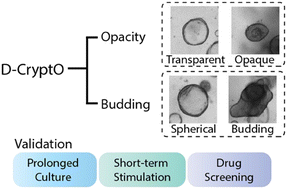D-CryptO: deep learning-based analysis of colon organoid morphology from brightfield images†
Abstract
Stem cell-derived organoids are a promising tool to model native human tissues as they resemble human organs functionally and structurally compared to traditional monolayer cell-based assays. For instance, colon organoids can spontaneously develop crypt-like structures similar to those found in the native colon. While analyzing the structural development of organoids can be a valuable readout, using traditional image analysis tools makes it challenging because of the heterogeneities and the abstract nature of organoid morphologies. To address this limitation, we developed and validated a deep learning-based image analysis tool, named D-CryptO, for the classification of organoid morphology. D-CryptO can automatically assess the crypt formation and opacity of colorectal organoids from brightfield images to determine the extent of organoid structural maturity. To validate this tool, changes in organoid morphology were analyzed during organoid passaging and short-term forskolin stimulation. To further demonstrate the potential of D-CryptO for drug testing, organoid structures were analyzed following treatments with a panel of chemotherapeutic drugs. With D-CryptO, subtle variations in how colon organoids responded to the different chemotherapeutic drugs were detected, which suggest potentially distinct mechanisms of action. This tool could be expanded to other organoid types, like intestinal organoids, to facilitate 3D tissue morphological analysis.

- This article is part of the themed collection: AI in Microfluidics


 Please wait while we load your content...
Please wait while we load your content...